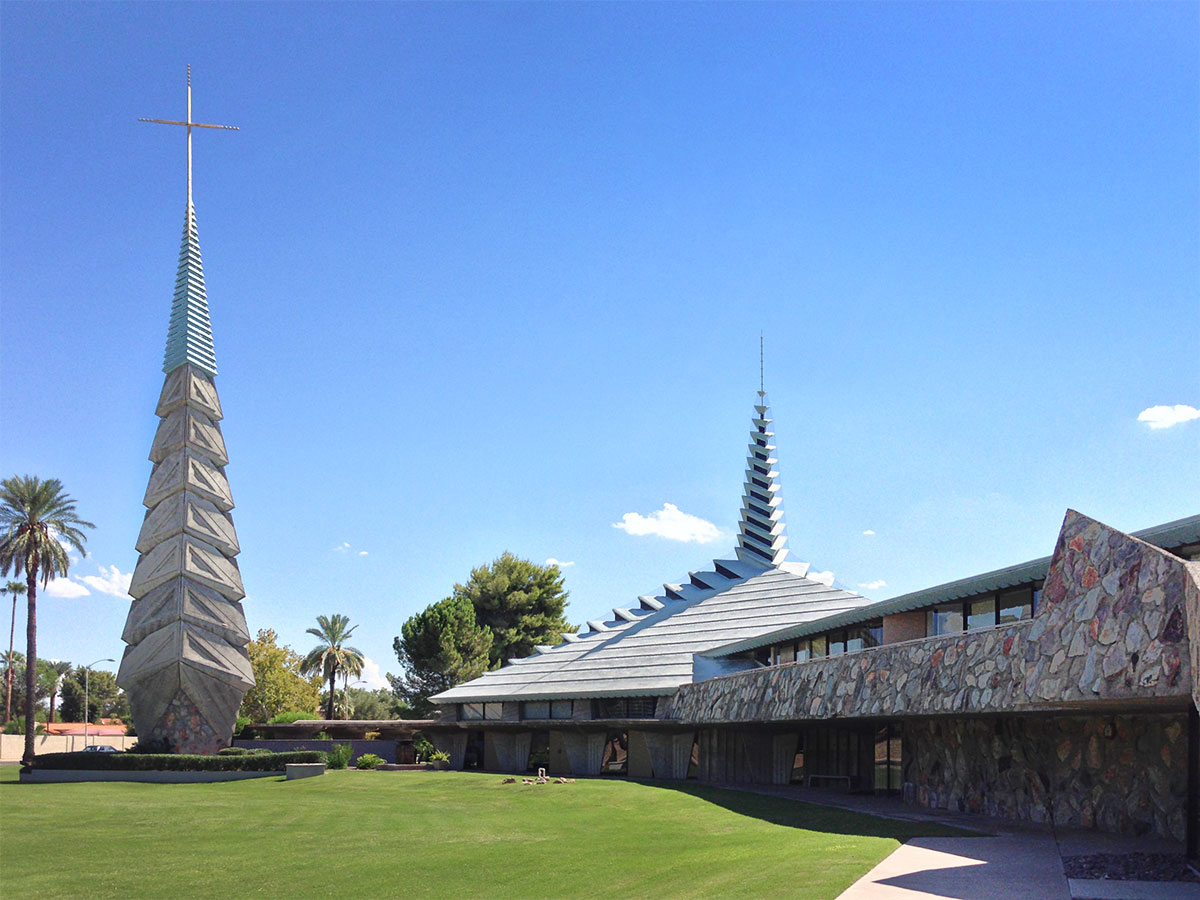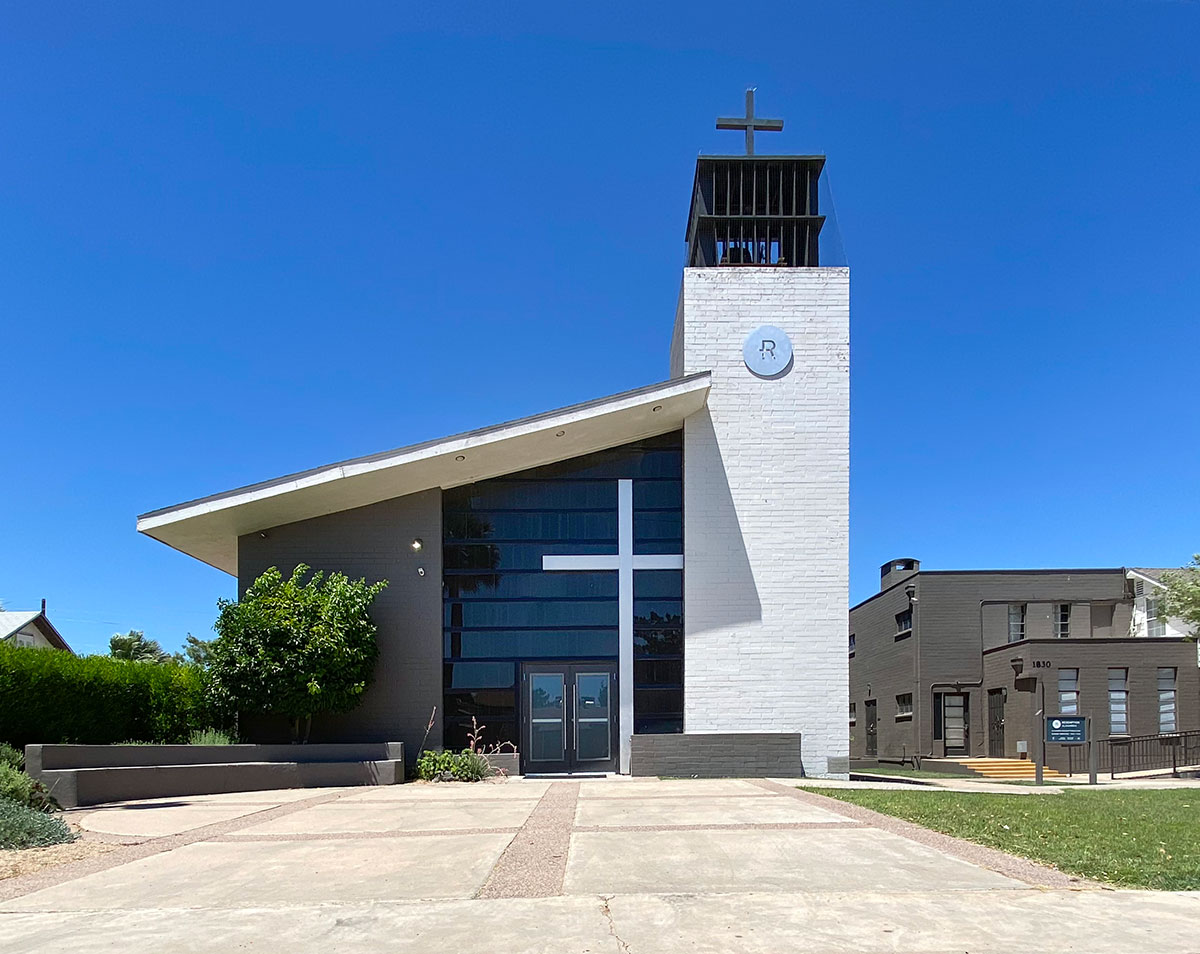
First, a good word from the Editor
Something happened in the 60s. All across the Valley of the Sun, congregations previously housed in borrowed spaces or sheltered by other churches suddenly erected magnificent, monumental and thoroughly Modern houses of worship. The burst in growth in this area is testament to the prosperity of families that had recently established themselves in the Valley, and their dedication to build a new city of daring new forms. It was time for the congregations, with all their various boards and committees, to project a vision of how they wished their congregations to be perceived. Architecture was advertising, after all.
And so, 40+ years having passed, Modern Phoenix has brought back one of our favorite writer/researchers, Walt Lockley, to help us make sense of the stuff.

While most sanctuaries built at the time are tame by today's standards, the Phoenix area houses an impressive collection of head-turning churches and synagogues designed by a group of accomplished architects that reads like a roster of Who's Who in Desert Architecture: Frank Lloyd Wright, Blaine Drake, Ralph Haver, Weaver & Drover, Frank Henry and Wendell Rossman to name a handful. Like much Googie architecture of the time, these holy houses were designed to turn heads on the street — though perhaps heavenward more than any other direction.

Surely inspired by stunning and organic designs such as le Corbusier's Notre Dame de Haut (a.k.a. Ronchamp) of 1955. it wasn't long after when Phoenix's own holy houses took form. Radical forms begin appearing as early as 1961. New developments in the application of wet-gun shotcrete (literally propelled concrete) also enabled the construction of organic forms in a relatively economical manner with less waste in less time. Unsaddled by the practical considerations of the compartmentalized spaces demanded by commercial building and tasked with the challenge of uplifting the human soul, religious architecture of Phoenix virtually soared in the 60s.

The words Space Age can't help but be evoked when looking at the inventory as a whole, with shotcrete rings literally orbiting around St. Maria Goretti and Camelback Seventh Day Adventist Church looking like as if the Mothership had truly landed. Even Ralph Haver's Valley Presbyterian chapel rises up from a wash like a ziggurat straight out of StarGate in its rugged but precise primitivism by turning his trademark low-sloping angles to work in an entirely different direction.

First Christian Church
Designed by
Frank Lloyd Wright in 1950 and built in 1970
Hyperbolic forms were the shape du jour, appearing everywhere from the aforementioned rings to structural arches and stained glass windows. As in most Desert Architecture, the struggle is all about light, light, light. How much to let in. How much to filter out. How to orient the space to the sun's path for best efficiency and aesthetic impact. Stained glass artists perhaps benefited the most, creating gorgeous designs that rival any in old Europe. Metal and stone arts also flourished, as custom-designed altars, furnishings, crosses, candelabras, holy water fonts and lecterns were needed.

Changes in the way parishioners worshipped at the time also shaped the building's form and function. An emphasis on participation and invitation to the altar created more community-oriented sanctuaries with more intimate worship areas situated within easy reach of of the congregation.
in "The New Church Architecture", a 1966 feature in Arizona Days and Ways Magazine by Marie H. Walling, architect Blaine Drake exclaimed that "We won't have stability in church design until society settles down." Has society settled down? We certainly have had less exciting churches erected in the 1970s and 1980, it seems. Churches of the 90s and even 2000s leave me cold. It seems the domain of church-building is a lost art full of safe committee decisions and beige exterior treatment. A few exceptions stand out, such as CoLab's St. Clare Chapel at The Casa, and the DeBartolo's Mariposa residence for the Brophy extended campus—but these are small, exceptional works in a sea of stucco.
Has society settled down? We certainly have had less exciting churches erected in the 1970s and 1980, it seems. Churches of the 90s and even 2000s leave me cold. It seems the domain of church-building is a lost art full of safe committee decisions and beige exterior treatment. A few exceptions stand out, such as CoLab's St. Clare Chapel at The Casa, and the DeBartolo's Mariposa residence for the Brophy extended campus—but these are small, exceptional works in a sea of stucco.


Holy Cross Lutheran by
Designed by William D. Knight Jr. in 1961


Visit our Community Map and click the BLUE path to receive a driving tour of our city's best midcentury modern churches.
|